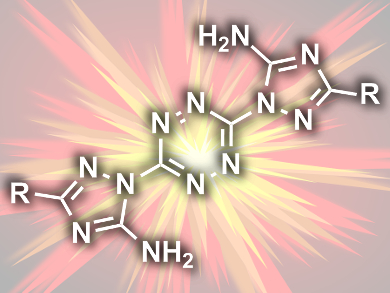Energetic materials (EMs), i.e., explosives, propellants, and pyrotechnics, need to balance stability and safety with detonation performance. Additionally, the compounds should be as environmentally friendly as possible and non-toxic. The stability of EMs can be improved by a planar structure, which leads to better crystal packing, and by amino substituents, which allow for stabilizing hydrogen bonding. A large nitrogen/carbon ratio improves detonation performance.
Alexander Aizikovich, Michael Gozin, Tel-Aviv University, Israel, and colleagues have synthesized several 1,2,4,5-tetrazine-bis-1,2,4-triazoles (example pictured) as improved energetic materials. The team combined 3,6-bis(3,5-dimethyl-1H-pyrazol-1-yl)-1,2,4,5-tetrazine (BPT) with 1H-3,5-diamino-1,2,4-triazole (DAT) in sulfolane to give the desired triazole-tetrazine derivatives. The amino-substituted compounds could be further functionalized to give bis-azido and dinitro derivatives.
The team tested the compounds’ stability and detonation performance and found high thermostability and low impact sensitivity, especially for the amino-substituted compounds. The detonation performance is limited due to a lack of oxygen in the compounds, but the addition of oxidants such as ammonium dinitramide (ADN) leads to greatly improved performance with high specific impulses and a large amount of gas release. Additionally, the compounds were found to be less toxic than typical nitramine explosives. According to the researchers, the developed EMs could be used as solid-state nitrogen gas generators and as components of solid propellants.
- Energetic Isomers of 1,2,4,5-Tetrazine-bis-1,2,4-Triazoles with Low Toxicity.,
Avital Shlomovich, Tali Pechersky, Adva Cohen, Qilong Yan, Monica Kosa, Nathan Petrutik, Noam Tal, Alexander Aizikovich, Michael Gozin,
Dalton Trans. 2017.
DOI: 10.1039/c7dt00935f




